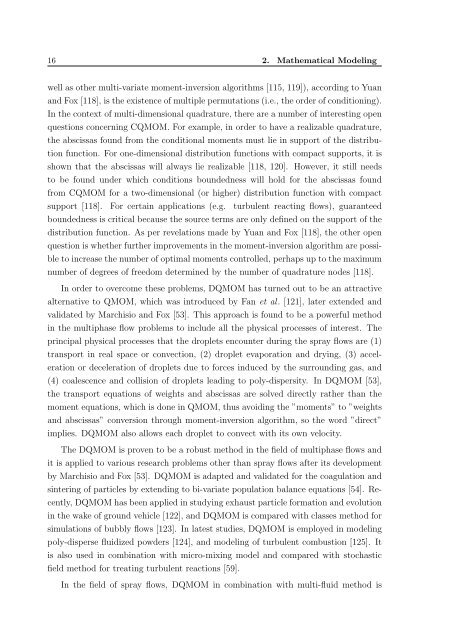INAUGURAL–DISSERTATION zur Erlangung der Doktorwürde der ...
INAUGURAL–DISSERTATION zur Erlangung der Doktorwürde der ...
INAUGURAL–DISSERTATION zur Erlangung der Doktorwürde der ...
Create successful ePaper yourself
Turn your PDF publications into a flip-book with our unique Google optimized e-Paper software.
16 2. Mathematical Modeling<br />
well as other multi-variate moment-inversion algorithms [115, 119]), according to Yuan<br />
and Fox [118], is the existence of multiple permutations (i.e., the or<strong>der</strong> of conditioning).<br />
In the context of multi-dimensional quadrature, there are a number of interesting open<br />
questions concerning CQMOM. For example, in or<strong>der</strong> to have a realizable quadrature,<br />
the abscissas found from the conditional moments must lie in support of the distribution<br />
function. For one-dimensional distribution functions with compact supports, it is<br />
shown that the abscissas will always lie realizable [118, 120]. However, it still needs<br />
to be found un<strong>der</strong> which conditions boundedness will hold for the abscissas found<br />
from CQMOM for a two-dimensional (or higher) distribution function with compact<br />
support [118]. For certain applications (e.g. turbulent reacting flows), guaranteed<br />
boundedness is critical because the source terms are only defined on the support of the<br />
distribution function. As per revelations made by Yuan and Fox [118], the other open<br />
question is whether further improvements in the moment-inversion algorithm are possible<br />
to increase the number of optimal moments controlled, perhaps up to the maximum<br />
number of degrees of freedom determined by the number of quadrature nodes [118].<br />
In or<strong>der</strong> to overcome these problems, DQMOM has turned out to be an attractive<br />
alternative to QMOM, which was introduced by Fan et al. [121], later extended and<br />
validated by Marchisio and Fox [53]. This approach is found to be a powerful method<br />
in the multiphase flow problems to include all the physical processes of interest. The<br />
principal physical processes that the droplets encounter during the spray flows are (1)<br />
transport in real space or convection, (2) droplet evaporation and drying, (3) acceleration<br />
or deceleration of droplets due to forces induced by the surrounding gas, and<br />
(4) coalescence and collision of droplets leading to poly-dispersity. In DQMOM [53],<br />
the transport equations of weights and abscissas are solved directly rather than the<br />
moment equations, which is done in QMOM, thus avoiding the ”moments” to ”weights<br />
and abscissas” conversion through moment-inversion algorithm, so the word ”direct”<br />
implies. DQMOM also allows each droplet to convect with its own velocity.<br />
The DQMOM is proven to be a robust method in the field of multiphase flows and<br />
it is applied to various research problems other than spray flows after its development<br />
by Marchisio and Fox [53]. DQMOM is adapted and validated for the coagulation and<br />
sintering of particles by extending to bi-variate population balance equations [54]. Recently,<br />
DQMOM has been applied in studying exhaust particle formation and evolution<br />
in the wake of ground vehicle [122], and DQMOM is compared with classes method for<br />
simulations of bubbly flows [123]. In latest studies, DQMOM is employed in modeling<br />
poly-disperse fluidized pow<strong>der</strong>s [124], and modeling of turbulent combustion [125]. It<br />
is also used in combination with micro-mixing model and compared with stochastic<br />
field method for treating turbulent reactions [59].<br />
In the field of spray flows, DQMOM in combination with multi-fluid method is













